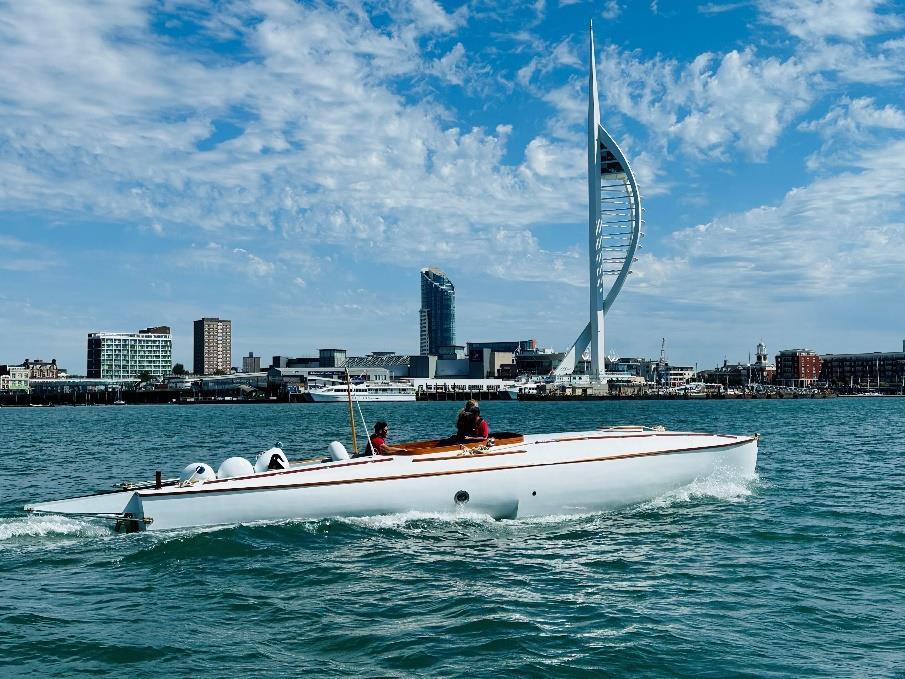Sponsors
National Historic Ships UK acknowledges the financial support of its sponsors


On 8 September, the newly-named coastal motor boat CMB4R (R for replica) took to the Solent for the first time, thanks to six years of research and hard graft by a team of 35 dedicated Boathouse 4 volunteers and partners of the Portsmouth Naval Base Property Trust (PNBPT).
Designed in part by one of the first female members of the Royal Institute of Naval Architects and famed for sinking the Oleg, a Russian warship, in 1919, CMB4 and its creation tells one of the great stories of innovation and design in naval history. It is more than 100 years since a coastal motor boat was last active.
History of the Coastal Motor Boat
The CMB was designed in 1915 by The Thornycroft Company, a shipbuilder experienced in designing, building and racing high speed boats in the years before the first World War. Owner Sir John Isaac Thornycroft and his children, John Edward, Tom and daughter Blanche all contributed to the design of the CMB. Despite being one of the first three women to be admitted to the Royal Institution of Naval Architects in 1919, it’s only recently that Blanche has begun to receive recognition for her contribution to naval engineering. Hamo Thornycroft, a former civil architect, marine draftsman and marine photographer is great nephew to Blanche and has been a part of the CMB4R rebuild team for almost a year.
At 40 feet long, the CMB is one of the most lethal small vessels used by the Navy during WWI. Its stepped hull was a revolutionary design feature that allowed it to reach impressive top speeds of nearly 40 knots (approx. 46 mph); a truly eyebrow-raising speed at the time of its inception, allowing it to slip by enemy defences. Such was its significance, sea trials for the CMB were held at night in order to keep it a secret from enemy agents. Equipped with torpedoes, speed and agility, the CMB made for a highly efficient attack boat during WWI and beyond, influencing high-speed boat design across the world, including the much larger and widely-used gunboat; a staple vessel in naval history. Made of wood, the CMB had limited defences against enemy fire, making the crew among the bravest in the Royal Navy at the time.
The Build
Building a replica of a 100-year old boat is certainly not without its challenges, even for the most talented shipwrights. However, Boathouse 4’s dedicated team of volunteers successfully built CMB4R with great craftmanship, hard work and one vital piece of history. Shipwright David Griffiths said: “The team have predominately used traditional boat building methods on CMB4R. War boats from this era were not built to last – they had pretty short life expectancy, as you can imagine. CMB4R is meant to look the part but is finished using 21st century technology to better preserve it for future generations.”
CEO of the Trust, Hannah Prowse, said: “This replica is the brainchild of Rodney Agar, nephew of the original CMB4’s most famed commander, Lieutenant Augustus Agar. Thanks to funding secured from the Chancellor’s LIBOR fund in 2016, we were able to make Rodney’s ambitious dream a reality despite boat building of this nature being now no longer widely practiced or documented. The influence of the CMB on naval architecture post-WWI is of such significance, it felt only right to recreate this revolutionary vessel so visitors to Portsmouth Historic Dockyard could appreciate and understand its impact."
"We must pay tribute to our wonderful team of volunteers led over the years by David Griffiths, Bob Forsyth and Diggory Rose, our partners Landau, as well as the National Maritime Museum, who provided the crucial plans of the original Coastal Motor Boat from 1915, without which they wouldn’t have been able to build such a high quality replica. A great amount of thanks also to the Imperial War Museum, who loaned us the original CMB4 currently on display in Boathouse 4, which was integral to helping the team understand the boat’s engineering.”
The new CMB4R will be added to National Historic Ships UK's Replica List, for replica vessels which have been built in the UK or abroad to a UK design. This List is entirely independent of the National Register of Historic Vessels (NRHV) but is intended to identify replica craft for the purposes of research, public interest, filming or charters and to promote the traditional skills involved in building and sailing these vessels
Source: Press release
Read more about Boathouse 4, our Shipshape Network South East Hub
 Zone
South East
Zone
South East
National Historic Ships UK acknowledges the financial support of its sponsors